A Walk in the Historic Neighborhoods of
Little Tel Aviv
Neve Tzedek Background
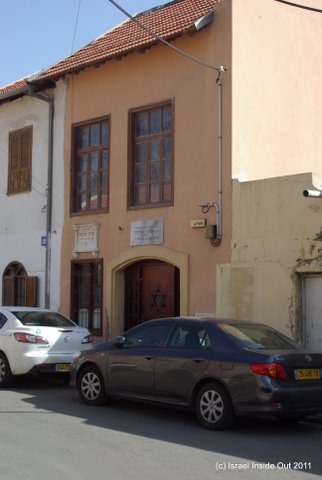
Neve Zeddek Synagogue
In 1887 the first seeds were sown that would eventually grew into the new city of Tel Aviv when a Jewish neighborhood called Neve Tzedek (also Neve Zeddek or Neve Zedek) was established outside the walls of the ancient port city of Jaffa. Three years later a second Jewish neighborhood outside Jaffa's walls, named Neve Shalom, was established nearby. Within the space of a decade these neighborhoods became the center of Jewish Jaffa's public and cultural life. Residents included Nobel prize winning author S. Y. Agnon, Israel's national poet Chaim Nahman Bialik and the painter Nachum Guttman, to whom a small museum in the neighborhood is dedicated.
In 1909 a group of 66 Jewish families gathered on a sand dune nearby to found a new city initially called Achuzat Bayit, but shortly thereafter renamed Tel Aviv. As the center of the new city shifted north, Neve Tzeddek and Neve Shalom were eclipsed by more modern neighborhoods and the area deteriorated. Slated to be demolished in favor of high rises, in the late 1980's and early 1990's Neve Tzeddek and Neve Shalom were saved from the wrecker's ball by proactive preservation activists and the granting of some additional building rights to local property owners. Today these neighborhoods are genuinely a pleasure to walk through, and of course don't forget to bring your camera.
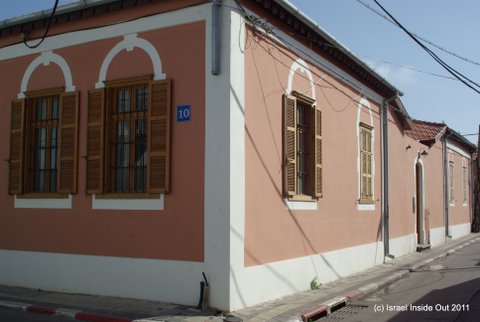
Neve Zeddek Building
Neve Tzedek Walk
We'll begin our walk on Hamered St. behind the Dan Panorama hotel. Cutting across some fairly unattractive looking parking lots takes us to Ein Yaakov St. Turning right (south) onto Ein Yaakov St. we follow it until Achva St., where we turn left. Along Ein Yaakov and Achva Streets we can still see some badly dilapidated houses. This is what the most of the neighborhood looked like 20 years ago. At Shabazi St. we turn right. Walking along the street we see through the renovated buildings the changes that have taken place since then.
At the shady corner of Elazar St. next to a restaurant named Suzanna, we turn into a pedestrian lane that leads to the Suzanne Dellal Center, where we pass through a building into an open court. Today it serves as a theater and the home of two of Israel's leading dance companies, the Batsheva Dance Company and the Inbal Dance Group, as well as the Orna Porat Theater for Children. In the early 20th century, the two buildings, which frame the open court were pioneering educational institutions, a Hebrew speaking girls school, and a French speaking boys school, the latter sponsored by the Alliance Israelite Universelle organization. The girls school was considered to be a radical innovator, not only did it offer girls a secular education, and in Hebrew no less, but its curriculum even included physical education! The linguistic differences between the schools were at the center of an ideological and cultural clash with the Zionist leadership favoring Hebrew education, while Alliance championed the promotion of French culture.

Neve Zeddek Old and New Cityscapes
We continue up a lane marked by an ice cream shop and turn right onto Chelouche St. Aaron Chelouche was a pioneering landowner and industrialist, who sold some of his property at a token fee to the Neve Tzeddek Society for Building Homes in Jaffa in order to encourage the creation of a new neighborhood. At the corner of Chelouche and Rokach Streets stands the former home of Rivka and Shlomo Aboulafia. The Nobel prize winning author S. Y. Agnon rented a room in this house and here he launched his auspicious literary career.
We continue up Rokach St. to find the Nachum Guttman Museum, dedicated to the local Tel Aviv artist, who grew up in the neighborhood in the early 20th century. Scenes of Tel Aviv and Jaffa in the 1920's – 40's are the subject of many of his paintings. Further up the street on the right is the former home of Shimon Rokach, today also a museum. Shimon Rokach was the neighborhood's visionary founder and his home was an important meeting place for local community leaders. The Rokach house was restored by his granddaughter, the sculptor Lea Mejaro Mintz, some of whose work is displayed in and above the front courtyard.
At the end of the street, actually across Pines St. at the corner with Yehuda Halevi St., stands an impressive Bauhaus building symbolically marking the end of the neighborhood and the beginning of a new era in Tel Aviv's history.
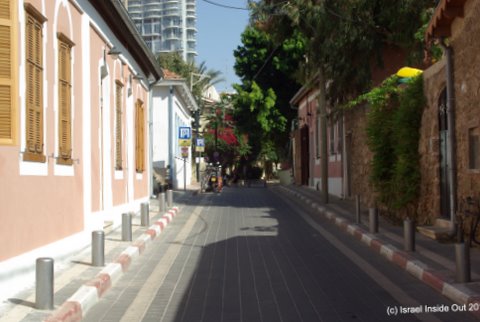
Neve Zeddek Street
Before leaving Neve Tzeddek behind, we will turn left and follow Pines St. to its corner with Lillienblum St. The yellow and pink stucco building with the round façade was the Eden Cinema. Founded in 1913, the Eden was Tel Aviv's first movie theater. Its founding necessitated the invention of a new word in the Hebrew language, re'i-noa, literally meaning moving image, was coined by Eliezer Ben Yehuda, the man who singlehandedly resurrected the Hebrew language. The open roofed cinema was later shut down during World War One by Jaffa's Turkish governor, who suspected its projector was being used to signal British and French warships in the Mediterranean.
From here it is a short walk to Independence Hall on Rothschild Boulevard, where David Ben Gurion read Israel's Declaration of Independence and the Nachalat Binyamin pedestrian mall, where there is an open air crafts fair every Tuesday and Friday afternoon. See also Shenkin Area
As this is a street based walk it is as wheelchair accessible as a normal public street.
See our photo album - Views of Neve Tzedek
Neve Tzedek is one of the oldest areas of Tel Aviv and it has recently enjoyed some renovation that has restored its old world charm in the heart of the Tel Aviv metropolis.
Neve Tzedek is a popular place for a pleasant stroll - see Neve Tzedek
Near to Neve Tzedek are some other popular Tel Aviv sites - Old Jaffa and the newly restored HaTachana (old station) complex.
Enjoy our photos of Neve Tzedek
Views
The ancient port city of Jaffa is one of the oldest cities in Israel and one of the oldest sea ports in the world.
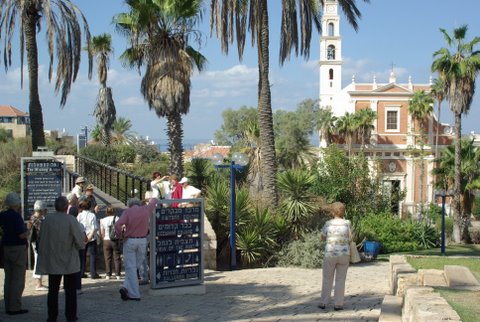
Old Jaffa
The multiple layers of human civilization that comprise its ancient tell (or mound), have yielded up discoveries as unique as an Iron Age altar with a lion's skull. Ancient Egyptian papyrus tells of the city's conquest by Pharaoh Thutmose III in the 15th century B.C.E. Thutmose's general used his own version of the Trojan Horse by sending baskets of gifts to the king of Jaffa with Egyptian soldiers hidden inside.
Later Jaffa is mentioned in the Bible as the port through which Solomon brought cedars of Lebanon to build the Temple. Jonah set sail from Jaffa's port, when he sought to flee the Lord and was swallowed by a whale. In the New Testament, Jaffa was the home of Simon the Tanner, on whose roof Peter had a vision that changed Christianity's relationship to Judaism ever since. In Greek mythology, a rock at the entrance to Jaffa's port is where Perseus saved Andromeda by slaying the Hydra.
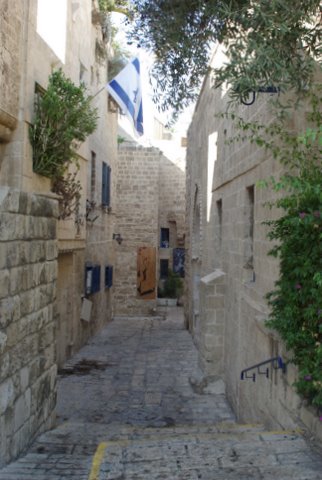
Jaffa's Artist Colony
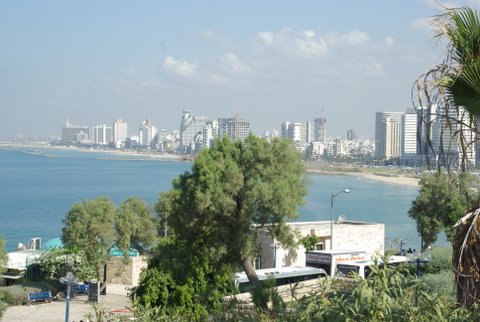
View of Tel Aviv from Old Jaffa
HaTachana - Station & Rails
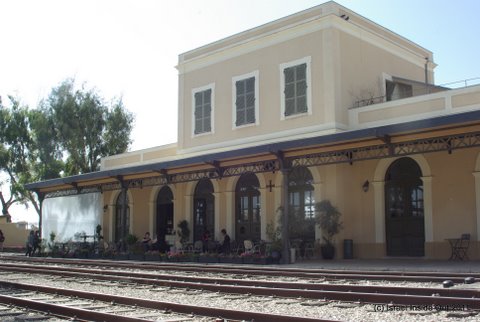
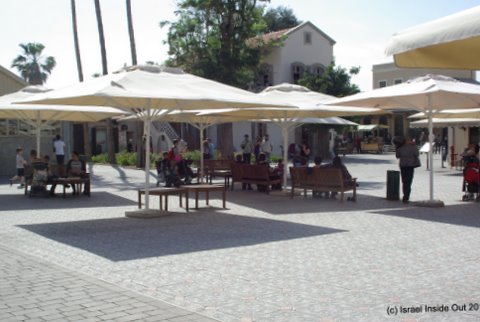
HaTachana - Station & Rails

HaTachana - Station & Rails
For a period of about 400 years that ended in the First World War, the whole of the Middle East was occupied under the rule of the Ottoman Empire based out of Istanbul. Israel's landscape still holds many reminders of those times. One of the nicest places is the Jaffa train station (that was the end point of the Jerusalem-Jaffa route). The coastal railway connected Turkey with Egypt and passed through Jaffa. The train journey to Jerusalem took around 4 hours (and is still a recommended item on the tourist’s itinerary - although it no longer departs from this station.) In 1913 around 183000 people travelled on the line to Jerusalem.
The compound called "Hatachana", ("The Station" in Hebrew) operated from 1892 and was abandoned when the rule of Great Britain terminated at the dawn of the state of Israel in May 1948.
HaTachana is situated exactly on the border between Jaffa and Tel-Aviv the compound was abandoned and the train routes were replaced with modern stations in other parts of Tel Aviv. In the last years the old warehouses and train station buildings (22 buildings in total) were renovated and the area became a very attractive entertainment and tourist center near the shore of Tel Aviv.
There are plenty of restaurants and shops are open for visitors who wish to relax either before or after a visit to Old Jaffa, the Jaffa flea-market or the Neve Tzedek neighborhood (the first Jewish settlement outside of Jaffa) – all within walking distance. Next door is the Israel Defence Force Museum.
HaTachana is an excellent place to stroll, browse, relax and recharge whilst absorbing history. There are plenty of bespoke shops and a choise of restaurants and cafes. There is also a food market.

HaTachana View
Part of the area will be devoted to a museum and as an area for international exhibitions, and for shows and music.
For more photos please see HaTachana Photos
HaTachana Opening Times
Sun – Thurs & Sat 1000 – 2200
Fri 1000 - 1700
Getting To HaTachana
Located a short walk south of the Dolphinarium (easy walking distance from the Dan Panorama & David Intercontinental Hotels & a slightly longer walking distance from most of the other beachfront hotels)
Located between Mered, Jerusalem and Eilat streets – exactly at the northern entrance to Jaffa
Dan Bus Routes: 8, 10, 100
The Shenkin area is one of the most interesting parts of Tel Aviv. Overall one of the best things you can do with a few hours in Tel Aviv.
The Shenkin area is one of the most interesting parts of Tel Aviv. Overall one of the best things you can do with a few hours in Tel Aviv.
Shenkin – One of the trendiest streets in Tel Aviv – perfect for meeting friends, hanging out and getting a coffee or a meal. Near the Carmel Market & Nahalat Binyamin & at the other end Rothschild Boulevard.
Carmel Market – You are either a market person or you are not. But if you are Carmel Market is everything you love, colourful, bustling, fresh produce, bits and pieces and with that special market smell and atmosphere.
Nahalat Binyamin - is a street close to Shenkin, and on Tuesdays and Fridays it turns into an out door crafts market. Come along, browse and maybe you will find the perfect souvenir to take home.
Rothschild Boulevard – One of the grandest streets in Tel Aviv, many buildings in the Bauhaus style (World Heritage Site).
The walks described here are all on the street, so they are as accessible as any street (and crowded market).

Frum East Ender who founded Tel Aviv
Israel’s first modern city was was born 100 years ago this month - thanks to a little-known, strictly-Orthodox Londoner
By Colin Shindler, April 16, 2009

Tel Aviv was founded on the second day of Passover, 1909. A crowd famously gathered on the dunes on April 11 and dreamed of the rise of an ir metropolinit — a modern Hebrew metropolis.
The new white city, inhabited by “the new Jew”, was established to be as far removed from the religiosity and squalor of Jerusalem as possible. It will therefore come as a surprise that one of its founders was Zerach Barnett, a strictly Orthodox Jew from London’s East End.
Neve Tsedek, today a yuppified district near the Tel Aviv shore, was the first Jewish suburb of Jaffa, created in 1887. Three years later, in 1890, Barnett bought adjacent land to create Neve Shalom, the area, along with Neve Tsedek, that was to become Tel Aviv almost 20 years later.
Barnett arrived in the Holy Land 25 years before Theodor Herzl paid his first visit. Before he set about his Tel Aviv project, he established the strictly-Orthodox settlement of Mea Shearim in Jerusalem, and was one of the founders of the city of Petakh Tikva in 1878.
Still virtually unknown in Britain, this one-man metropolis-builder was actually born in Tytuvenai, a small village in Lithuania, in 1843, lived until he was well into his nineties and was buried in Jerusalem. At yeshivah in Lithuania, he was highly influenced by his teacher, Rav Avraham Kreiser, who “yearned to see the blossoming of our Holy Land and to participate in its upbuilding”.
In his long-forgotten memoirs, Barnett reveals that he did not want the shidduch arranged for him with Rachel Leah, daughter of Yitzhak HaCohen of London, because he ardently wanted to go to the land of Israel with his rabbi.
Eventually he settled for the match, and a life in Britain. He soon became involved in the founding of small shtibls in the East End, based on the Vilna model, which eventually amalgamated as the Federation of Synagogues.
Through initiative and hard work, he was able to build up a thriving business in the fur trade with contacts in Leipzig and Paris. He received his British passport after seven years in London and immediately made plans to travel to the Middle East. He left London in 1872, with his wife and his two-year-old daughter. On arrival, he was disappointed to discover only eight Ashkenazi Jews among the Sephardim of Jaffa — “not enough for a minyan”, he remarks.
This first visit to search out land for Jewish settlement led to another 14 in as many years, much to the consternation of his wife and growing yet unsettled family. His shuttling between London and Jerusalem was directed towards earning money in the British capital and spending it on land purchases in the Holy Land. His obsession was not received with encouragement by his friends. In London, they thought his actions ridiculous if not mad, in Jerusalem they were perceived as verging on the heretical.
His daughter, Hannah, recalled the disapproval felt by the Orthodox inhabitants of Mea Shearim in her memoir in the 1920s. “In their eyes, the duty of a pious Jew was to study the Torah and to wait for the restoration of Palestine by miracle, and all this talk of buying land, piece by piece, and of building and farming, was little short of sinful,” she wrote.
But Barnett persevered. In 1890, he purchased 70,000 square metres of land abutting the Arab neighbourhood of al-Manshiye, named it Neve Shalom and settled there permanently.
He started to build houses for the increased number of Jews living in dire conditions in neighbouring Jaffa, and in 1896, he finally fulfilled his life-long ambition of building a large synagogue in Neve Shalom, accommodating Sephardi, Ashkenazi and Chabad services in its different rooms. Now he finally had his minyan outside of Jerusalem.
Colin Shindler is professor of Israel Studies at SOAS, University of London. His History of Modern Israel was published by Cambridge University Press in 2008
Map of attractions in Tel Aviv
Most Popular attractions
- Shenkin and Dizengoff streets will offer it’s lively atmosphere for anyone who wants to get the feel of the city as well as a variety of shopping opportunities.
Tel Aviv’s main artery is filled with busy pedestrian traffic, shops, cafes, art galleries, boutiques and wine bars. - Carmel Market and it’s neighboring Yemenis Quarter will charm you with it’s colorful vitality and small restaurants offering simple but delicious meals.
- Rotschild street and the Neve Tzedek district feature Bauhaus style buildings and beautiful cafes and restaurants.
Neve Tzedek and Neve Shalom were the first two Jewish neighborhoods outside the city of Jaffa, even preceding the establishment of Tel Aviv. The two neighborhoods consist of narrow, winding streets, and are located not far from the sea, between the Carmel market and Jaffa. - Old Jaffa is a joy to walk both during day and night. The Port area has a lot to offer. Whether you are looking for a pleasant place to have dinner or a pub, it has it all.
According to Christian legend, Jaffa was named after Noah’s son, Japhet, who built it after the Flood. There are others who believe that the name derives from the Hebrew word “Yofi” – beauty. - Tayelet – This is the paved beachside walkway which provides a 2km path between Tel Aviv and Jaffa.
- Tel Aviv Museum of Art – This museum features a rich collection of art including European works from the 16th to 19th centuries, Impressionism, Post-Impressionism and 20th-century modernism.
Points of Interest Nearby
- Tel Aviv Museum of Art
- Suzanne Dellal Centre
- Old Tel Aviv Port Area
- Tel Aviv Performing Arts Center
- Nahalat Benyamin Visitors Center
- Tel Aviv Marina and Sea Center
- Migdal Shalom Tower
- Neve Tzedek
- White City
- Kerem Hatemanim
- HaTachana
- Habimah Square
- Dizengoff Street
- Old Jaffa
- Sheinkin Street
- Jerusalem Beach
- Frishman Beach
- Clock Tower
- Opera Tower
- Dizengoff Fountain
- Eretz Israel Museum

No comments:
Post a Comment